 |
 |
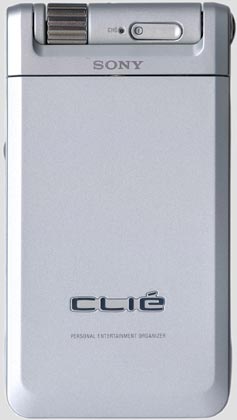 ... ... ... ...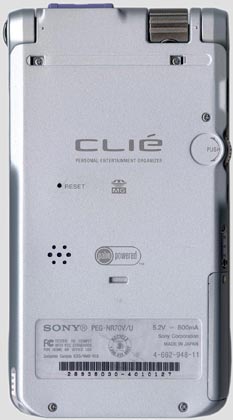 |
|
|
| .
But the NR70V screen does another amazing trick - it's protecting itself. 180 degrees turnable, it can 'look' toward the unit or toward the user. It's hard to describe the movement, so I prepared a little animation. Just click on the images below to start a 6 second movie that shows it quite clearly (choose HiRes DivX or lousy Real quality <g>). . |
..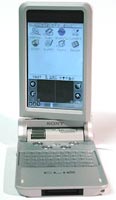
DivX - 768x576 - 860kB |
.... |
 ..
..RealMedia - 384x288 - 125kB |
| .
With that swivelling screen, the NR70V does not only need an extra screen protection, but you can also use it in two ways. In your hand like any PDA or more like a tiny notebook on the table with the screen in a vertical position. Sony had to consider some tricky details to realize that solution. Apart from the nightmare of connecting the LCD to the main board (more about that a little later), the LCD content had to be flipped vertically when the screen is used the one way or the other. The NR70V has indeed a contact build into the swivel hinge, that gives a feedback about the orientation of the lid. At a certain position while turning the LCD, the screen content is flipped upside down. And - typically Sony - the constructors made another good use of that contact. When the lid is closed and the LCD is inside, the power button is not working (which BTW needs another feedback contact in the lid hinges). You can put the NR70V in any pocket without the danger to switch it on accidently - IMHO the first PDA that solves that important detail. But when the screen is looking outward and the lid is closed too, the power button IS working normally - a marvellous detail I just love! . And then, there's the integrated keyboard. . |
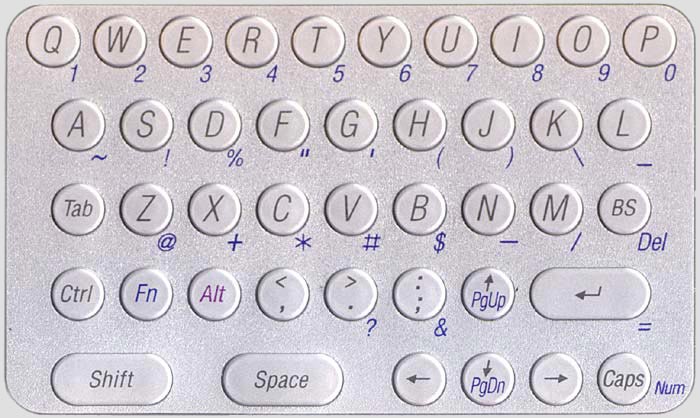
|
| .
Of course you can't expect a full blown keyboard, but what you get is working well. The keys have a nice tactile feedback and the layout is ok considering the given space. I wouldn't plan to write a whole novel with it, but it is perfect for a quick email or some larger notes. Whoever tried to reply an email with Graffiti input, knows what I'm talking about. Only all the special characters like %, # and all the slashes make it worth to use the keypad. . But let me come back to the screen once more since I didn't talk about the soft Graffiti area yet. As mentioned, the NR70V has a resolution of 320x480 which leaves 160 pixels vertically unused for most of the standard Palm apps. However, only special HiRes+ applications are using that bottom part of the LCD (note the '+', since HiRes without it stands already for the 320x320 resolution). The OS of the NR70V implements a beautiful Graffiti and status area on these 320x160 pixels. Imagine, that area alone has double the pixel count of the whole screen of a Palm m515! . |
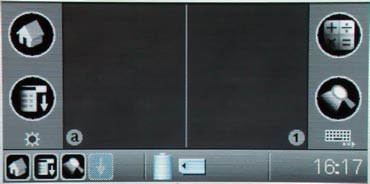 ... ...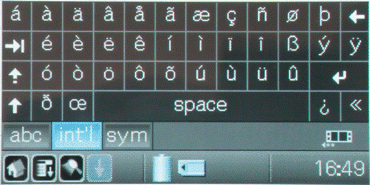
|
| .
There are the usual 4 soft-buttons, only everything is 'drawn' of course. Additionally you'll find a symbol to call the brightness setting and the Palm OS keyboards (alpha and numeric). New is a keyboard symbol below the Find icon which calls a special keyboard that replaces the Graffiti area. It has a few advantages over the standard Palm OS keyboard. One for sure is, that is doesn't need space in the application area. But it also offers basically every printable character on three different layers. All in the bottom a status line duplicates the most important soft functions like 'Home', 'Menu' and 'Find' in case an app uses the Graffiti area in HiRes+ mode. Additionally there's a tiny battery symbol, memory stick indicator and the time. There are already 'skins' that modify this tiny area to different tastes :) ... Last not least there's a tiny 'down-arrow' that allows well programmed HiRes+ apps to be switched between 320x480 and 320x320 pixels or in other words, with the arrow you can manually show or hide the Graffiti area. But as I said, only well behaving applications are allowing that. A good example for a very well behaving app is - what a coincidence - the all time star 'datebk 5'. But most of the time the arrow is grayed out and without function. It is a bit disappointing, that Sony didn't supply even a single app that makes use of the huge resolution. Ok, there is the picture viewer called 'Picture Stand' that shows images in full resolution, but only after you started an automated batch process for a slide show. Not even the normal pic viewer uses the 480x320! Oh, and then there are the 'Pro' apps, like the PalmReader. It took them ages to supply the 320x480 at all (if I'd distribute a book reader, I would rather lurk for such a resolution), and now you can _only_ use the HiRes+ on a NR70V. The arrow is working however, but the text in the lower part of screen is simply covered by the Graffiti area then and you can't read it anymore. All in the end of this review, you'll find my personal pick of all HiRes+ apps ... :) . |
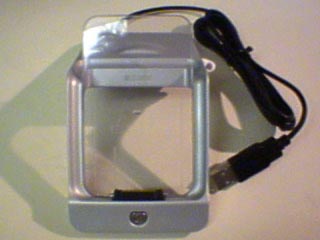
|
| .
Sure, you can see what it is, but what's the use of such an image? However, there is one nice feature for the camera. The address book of the Clié is modified to hold also a tiny image for each record. So if you tend to forget how your contacts look like, you can attach a picture taken with the camera. The mechanical solution of course is marvelous. The complete camera is build into a 15 mm cylinder on top of the case, which can be turned about 270 degrees. So the lens can look in any direction within these 270 degrees. That makes it necessary to flip the image from a certain turn point on (yet another sensor!), otherwise the image would be upside down when you turn the lens 180 degrees. That flip point is reached when the camera is looking into the sky, assuming the Clié is held nearly vertically. When you turn the lens completely inward towards the case, it's mechanically perfectly protected. Though, dust can still reach the lens, there's no tight seal or any other dust protection. . |
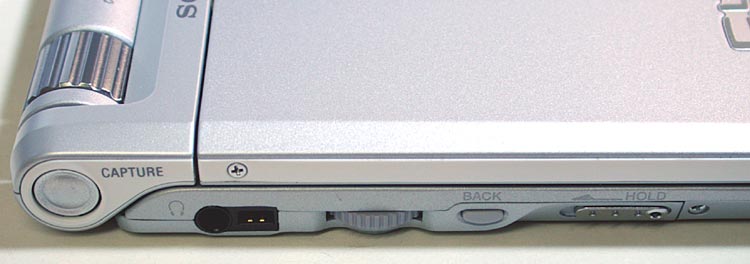 ... ... |
| .
On the image above you can see the cylinder quite well, that's how it looks when the lens is hidden. Also visible is the 'Capture' button I did't mention yet. Pushing it not only takes a picture, but also calls the 'Camera' application in case it's not yet running - that's very handy. There's not much more to say about the camera unless you want me to rant about how 'underqualified' it is to challenge the excellent display. It'll be the new NX70V that will bring that whole camera feature to true live. Not only that it'll come with a resolution of 640x480 which is at least usable to shoot web-images etc., but with the new ARM power, the NX70V will also be able to record tiny MPEG-4 movies. Now, even the 200MHz ARM can't compress 640x480 on the fly, so movies are limited to 160x112 ... but that's another unit, back to the NR70V. . |
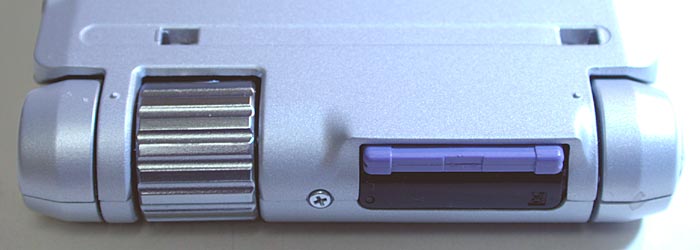
. |
| On top, you'll find the MemoryStick bay as well as the infra red window.
Behind that slightly wider window, the NR70V hides not only the usual integrated
transceiver that takes care of the IrDA communication, but also an additional,
discrete infrared transmitter diode that supplies the 'juice' for the IR-remote
application. Unfortunately Sony didn't include a learn mode (IMHO easy possible
with the receiver of the IrDA part), but if you find your TV, VCR etc. in the list
of supported devices, you're rewarded with a much better range than the pure
IrDA tranceiver would allow. . |
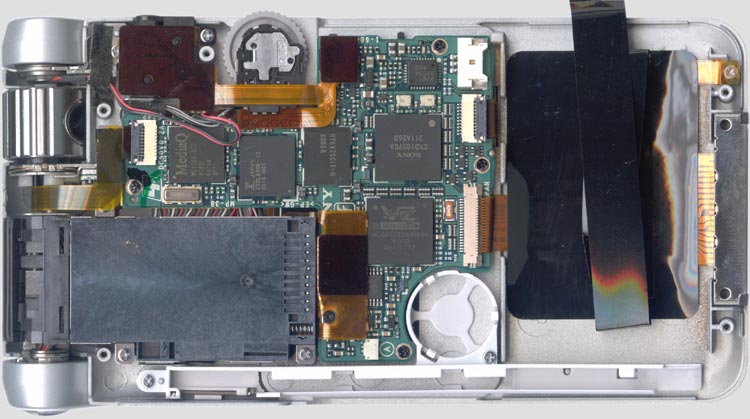 . .. |
| As you can see, Sony had to spare alot of room for non-electronics like
the battery, the memory stick slot, the jog-dial and the speaker (removed
in the image, left of the memory stick). Considering that the NR70V chip
count has grown again, the main board had to be high density assembled and
all LSIs are coming in space saving BGA cases (ball grid array). Looking
closer at the chips, you'll find a novum already in the CPU. It's a 66MHz
type and never before was a Dragonball clocked that high. It's nearly a pity,
that Motorola came out with it now as the Dragonball days are numbered. Since
this review comes 'a bit late', we know that the new NX70V is no longer using
the Motorola CPU, but a TI chip with ARM kernel. Anyway, the NR70V benefits
alot from its fast CPU. It's 'snappy' and the high resolution doesn't harm
the screen refresh time. Of course the CPU does not all the work. Again there's
a multimedia chip from MediaQ, the MQ-1168. Unfortunately MediaQ thinks they
have to protect their datasheets with a password. I didn't even bother to
check what it needs to get one, but let me say a little side note here (MediaQ,
are you listening?): I'm a professional hardware developer and our 'bibles'
are datasheets. We need them ready available, anytime, when we have to decide
which chip might qualify for a certain project. A company that protects their
datasheets is right away out of the race! Sure, I might not be the biggest
customer (well, with Sony using the chip I'm definitely not <g>), but
alot of developers are thinking like me and they add up. So guys, please!
What's the big secret? But back to the Clié. I found a brief description
of the MQ-1168 which should be anyway enough for a review: The MediaQ MQ-1168 Multimedia Platform Controller makes video capture and playback a reality for handheld devices with a built-in video input module, a dedicated 8-bit video input port, and a video engine called StretchBLT. Any CCIR656-compliant video -- either from the dedicated video input port or from the CPU -- can now be handled in hardware. The MQ-1168 performs advanced functions like color space conversion and image scaling in hardware, which otherwise would tie up the entire CPU if executed in software. From that description you can guess, that the NR70V is not using all the potential of the MQ-1168 and I bet it's on board of the new NX70V too, which is able to capture small movies with its camera. But I wouldn't hold my breath for software making the same possible for the NR70V. After all, the CPU has some duty in that process too and the Dragonball or its memory interface might really be too slow for that task. Since the MediaQ does obviously the video part in the NR70V, I honestly can't tell you what the other LSI, the CDX1859 exactly does. But considering the many functions of which each single one would overload the CPU, I think it's either doing some MemoryStick/MagigGate stuff, MP3 decoding and/or controlling of the high-res LCD. It's of no big interest anyway, since low-level programming (aga hacking <g>) of these high complex chips is long gone. Let's look at some details of the construction instead. . |
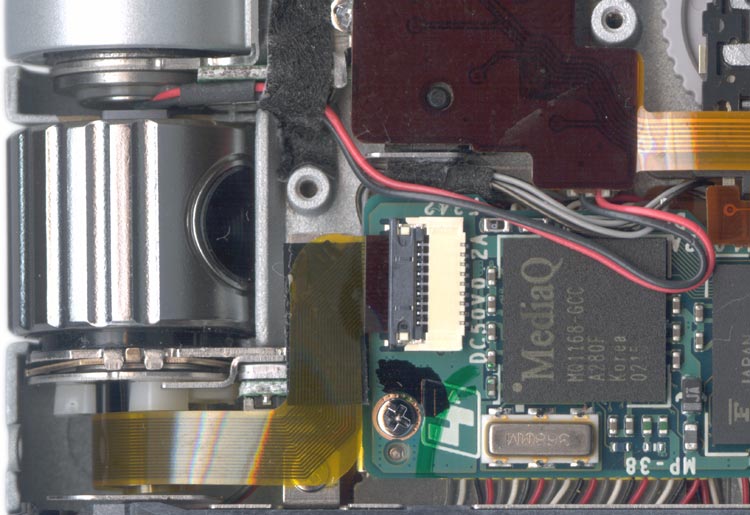 |
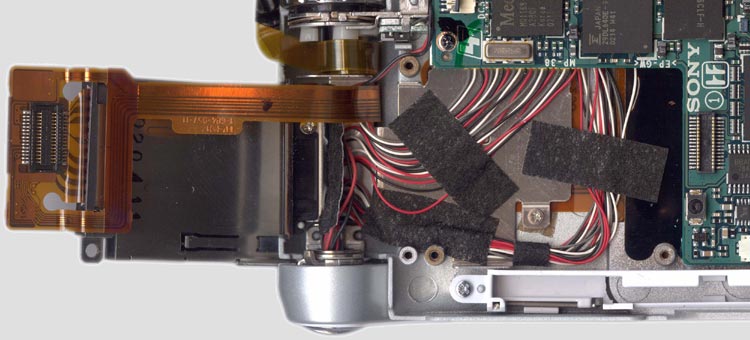
. |
| Removing the memory stick connector reveals the most
extravagant solution to connect 40 pins to an LCD screen: single wires! But
there's nearly no other solution to squeeze 40 connections through an axles
of only a few mm diameter. Additionally they have to be flexible enough to
hold a life time of turning the screen back and forth. I hope you have some understanding for me
now, that I didn't disassemble my NR70V any further ... I really wonder how
Sony assembles that thing economically. . |
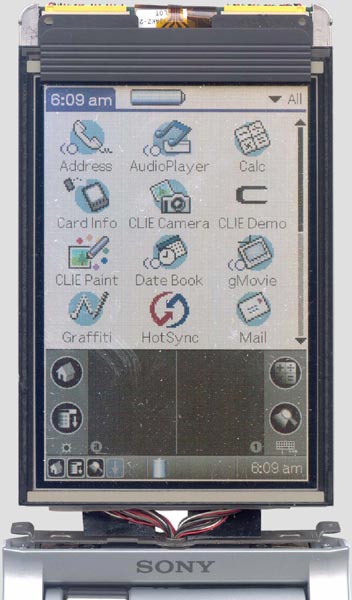 ...
...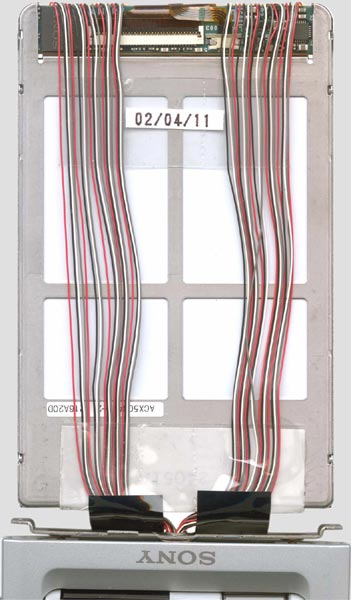
|
| The wires are consequently fed further behind the screen to
their connectors. If you like puzzles, try to figure out how and when Sony
has to assemble the connectors on both ends which DON'T fit through the swivel
hinge :) ... . |
|
The memory stick problem . I think I don't need to say too much about the memory stick in general. It's used like all other external memory devices with Palm OS. But there is a 'semi-official' problem with the NR70V and the memory stick. I call it semi-official since alot of users had problems but Sony never confirmed serious problems. Anyway, a few weeks ago it struck my Clié too. The memory stick wasn't recognized anymore, just like it wouldn't be inserted at all. Funnywise at that time I didn't even know that a 'general' problem exists. But since I had taken my NR70V apart, I knew where a contact problem could occur and of course I did blame me for the problem :). So I took it apart once more and checked the seat of that really tiny connector between the plastic flat cable towards the memory stick bay and the main board. You can see the connector on the picture above (most left the female part on the flat cable and most right the male part on the main board right below the Sony logo). I just removed the connector once more, inspected the contacts with a magnifying glas and reseated the cable with the connector again - taking special care that it 'snaps' in place properly (as far as you can call that tiny action 'snapping'). Generally I didn't have the impression that I found a problem and closed the Clié again a bit frustrated. But surprisingly the memory stick worked again after that second 'surgery' and didn't fail since then. I can't say whether I just had luck and whether that cure works all the time. But once you see that connector yourself, you know why I think it is possible that it came slightly loose. If the problem reappears, I even thought about fitting some thin rubber layer or such above the connector, so the case lid would hold it down when the device is closed. But so far it works fine and I have no reason to improve my 'repair'. ATTENTION: In case you want to try my fix, please note that there are some screws holding the memory stick slot in place! Before you can remove the connector, you have to remove these screws! . |
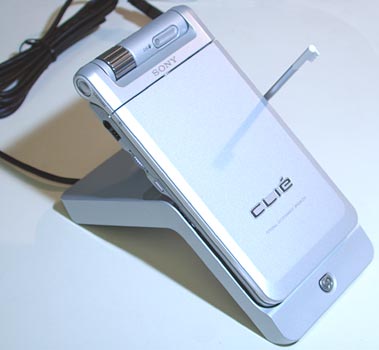 . .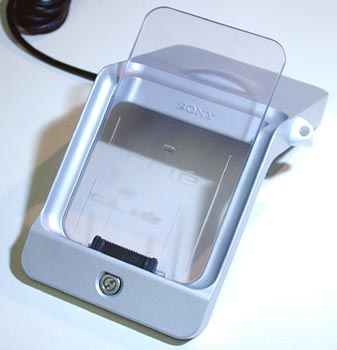 . . |
| .
As mentioned, Sony used the same connector as on the T615 which works nice and smooth, but has the same disadvantage as it had already on the T615. The plug coming from the power supply is mechanically 'converted' by the cradle and you can't connect the power supply directly to the unit. You definitely need the optional adapter when you want to charge the Clié on the road, since carrying the huge cradle is definitely no choice. There are also two seperate cables running across your desk for power supply and the connection to the PC. It's a pity that they didn't implement the trend towards one cable that splits up under the desk. The supplied cradle is a pure USB type. And unfortunately there's no easy modification to RS-232 like it was possible with the Palm m505 for example. The reason is, that the NR70V has no RS-232 drivers on board. They are located in the optional serial cradle or serial hotsync cable or such (I guess something like that is available, honestly I didn't check it!). On the table below, you can see all the pin functions of the 18-pin connector. . But please read the following notes carefully, before you start fiddling with your device!!!
|
. |
|
Power supply and power consumption . In the past, I made alot of efforts to meassure the power consumption of PDAs as exactly as possible. With and without backlight, with RS-232 and without and so on. But meanwhile the units are just too complex and their power managements too nifty, to cover all possible scenarios. With the NR70V it has become even 'worse'. There's the variable backlight, the MP3 player working with or without the LCD, in the background or not, there's the camera module and and a lock switch. In other words, your milage may always vary, no matter what I'd assume :). What I can say is, that the Clié is supplied by a relatively large Lithium Ion cell with about 1000mAh. With low backlight and no particular power consuming action, you'll get around 5-6 hours continious operation. With no backlight at all (which I don't consider an option with that nice screen <g>) you can stretch the life time about 1-2 hours. The backlight is not playing that big of a role as it once did on the old Palms. The large LCD itself and the complex electronics of the Clié just want to be supplied. And yet one more word about the backlight: I personally have it all the time on the lowest level, I find it still quite bright in that mode. Bringing it up to its maximum shortens the battery life time alot (about 3 hours then) and does not really look that much brighter. Exception might be if you watch alot of images on your Clié. The colors are indeed more brilliant with the highest setting. However, the NR70V is for sure not the most power consuming device for the road. Additionally its cradle is really nothing to carry. So be prepared to get some kind of travel kit if you're longer away from your cradle. In case you want to do an own solution, the NR70V needs 5.2V to be charged. The delicate LiIon charge process is done by circuits in the Clié, so a stabilized voltage is enough. But it really has to be 5.2V! The much more common 5.0V won't work or rather, they wouldn't fill up the battery very well. Sony supplies a nice switched power supply, so they had no reason not to pick that strange number. There are of course tricks to lift the output voltage of a standard 7805 a little (just place 1 or 2 standard 1N4148 diodes in the ground line of the 7805), but be warned: A linear regulator might easily be overloaded. The NR70V consumes up to 800mA when it's operating and charging an empty battery at the same time. If you plan to build for example a converter for the car, you had to bring down worst case ~14.5V to 5.2V which means 'killing' over 9V. At 800mA that again means to convert over 7 Watt into heat - believe me, without a ludicous heat sink, any 7805 will be blown in seconds. Or rather, it will melt itself through its case and still not put out 5.2V, because the thermal protection kicks in constantly :). A better approach is a tiny 'switcher' (switched regulator). For all of you hobbyists and semi-pros out there, take a look at National's 'Simple Switcher' LM2675-ADJ (the suffix ADJ is important!). With a single coil and two resistors you can produce any output voltage with that chip, it supplies up to 1 Amp and doesn't even get warm. Check the data sheet at National, there you'll find also an application example. Once you supply the NR70V with whatever you got :), it shows an ongoing charge process with a tiny orange light beside the power button. And that light goes off indeed when the battery is full, which is nice - I always missed that one on other devices. But I have the impression, that the light is on for a very long time. According to that LED, the charge process takes 3 hours and longer which might be true if you look at '101%' charging. Most of the 'juice' is back after 1-1.5 hours. . |
|
Bottom line - You have to get used to the NR70V, but if you can live with it, it's IMHO the best PDA you can buy in the moment (please, no flames from the WinCE world, this is a PalmOS site <g>). The price is quite high, but compared with its features, you have to consider it even as cheap - given of course, you make use of all the features. Add up the prices for a web camera, an MP3 player, a voice recorder, an ebook reader and a wireless email/web station only, then you'll know what I mean. And then you have no PDA yet :). Yes, surprisingly the NR70V holds also all your addresses, appointments and notes and is able to present them on its superb screen as no other PDA can do. The battery life is ok, not great but not poor either. We have to make a choice nowadays - either you want all the bells and whistles, then you have to pay battery life for it. If you need as much battery life time as possible for an address book only, get a Zire that's spartan enough to spare even the backlight :). If you want to spend the $540 (street price, list is $599) for the new NX70V, there's hardly a reason to buy still an NR70V. Only two things come to my mind: The battery life with the new 200MHz CPU might be gone down again (I'll check that once I have an NX70V) and the CF slot makes the unit slightly bigger (though, only in the top part). Then again, if you look mainly at the HighRes+ screen, the keyboard, the MP3 player or other goodies the NR70V had already, you might be able to get an NR70V for a bargain on ebay or such. And there's another thing to consider with the new NX70V. It runs on OS5 which is a much bigger step than the version number tells. Native OS5 apps have to be written (or rather compiled) for the ARM kernel and old OS4.x apps just don't run on the new CPU. Of course OS5 comes with an emulator for Dragonball apps and older apps which are 'properly' written according to the API should work. But we all know, an emulator is never like the 'real thing' and we know also, how annoying it is, if your favourite app of all apps is the one, the emulator doesn't like. Sure, major apps like datebk or such will be soon available (or already?) for OS5. But other apps - and I know what I'm talking about <g> - are written by people that are no longer in the 'Palm coding business' and there won't be updates anymore. No, I really don't vote against OS5 - it was about time that the Palm world catches up with WinCE and it's multimedia capabilites. I'm just considering ... :) ... . And all in the end, let me introduce you a discovery I made not very long ago. It was truly one of these moments, you think you hit the jackpot :). I have to say first that for far over 10 years now I'm using an HP calculator for my daily work, engineering as well as making my tax declarations. It's an HP48 and I love it, mostly of course because I'm so used to it. I'm also a true UPN lover, and I'm used to that system as well. On the other hand, I was still searching for a nice calculator on my Palm - excuse me if I don't consider the supplied PalmOS calculator app as a true choice. And last not least, I had that beautiful NR70V LCD, which hardly any app made use of ... and then I found IT: . . What you see above is a real screen shot (no POSE, true image of my device) of the ultimate HP48 (SX or GX, selectable) emulator. I had to offer the highres version of the image too, because it is so beautiful. Just click on the image as on most of the images on this page. It's called 'Power48' and written by Robert Hildinger. It is free (under GNU license) and available brand new as of Oct. 14th, version 0.9 beta. But believe me, that beta is much better than alot of release versions - on my Clié it works so far flawless. The bad news first: There is a website for Power48 at www.mindspring.com/~hildinger/Power48, but when I wrote that review and tried to look up the page, I got a strange message that the bandwidth of that particular page has exceeded for this month (Nov 2002). Hopefully that super app will get an appropriate home soon! UPDATE Nov 2004: It HAS a new home! You'll find it all on http://www.mobilevoodoo.com . . But back to the app: Power48 is a true emulator, emulating the proprietary 'Saturn' CPU used in the HP48 on the Dragonball. Consequently, you need to load also the ROM images of the HP48, which you can get on www.hpcalc.com. Because of the perfect emulation of the Saturn CPU, you won't miss anything you know from your real HP48 - Power48 is working like the real thing. The only detail I missed is the infrared port on the HP48 (to talk to a printer for example), but the documentation of Power48 shows that issue as already 'in work'. After all it's only a beta so far. The speed of the emulator is great and just a tick slower than my real HP48SX (which is not the fastest calculator from that series). But the author talks already about the new NX70V with OS5 and the ARM CPU. Best, I quote the 'whole' FAQ here which consists so far of the following two questions only: . Q1: Do you currently support, or have plans to support other devices? A1: The reason Power48 supports only Sony Cliés is that at the moment they are the only ones that have the necessary processing power, high-resolution screens, and high-resolution API's. As of this writing no other Palm device has all of these three items. There doesn't seem to be any reasonable way to provide an HP48 button interface on a screen with 160x160 resolution. You, however, are certainly welcome to try! If you can come up with a way to do it that doesn't involve massive scrolling, then perhaps Power48 can be updated for this class of device. . Q2: Do you plan to support OS 5? A2: And how, baby! The core of Power48 is a major candidate for conversion to ARM native code, and when that happens the speed of Power48 should easily exceed the real thing. Since OS5 includes a native high-resolution API, it satisfies my conditions from Q1 above. . Does that sound promising? I think so and I can't wait to see Power48 progressing. It was, as I mentioned, a real nice moment to discover such a well done, high sophisticated, FREE app in our money driven world with meanwhile much too much crap for much too much money! If you happen to own a high-res Clié, check out Power48 for yourself! . |
|
. Last updated: November 17th, 2002 Copyright © 1997-2002 by Peter Strobel, all rights reserved. |